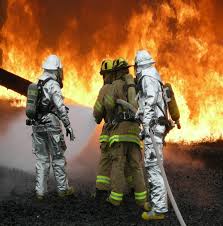
A few weeks ago I wrote about one of the two presentations that caught my attention at the ARFFWG Chiefs & Leadership conference: NTSB Hascom. This week I wanted to highlight the other presentation: NFPA 1851 – The Risk Assessment Flight Plan, as I believe it had an important point.
Senior Captain Ronald Krusleski and Assistant Fire Chief (Retired) Jessie Gentry presented on the topic of risk assessment as it relates to NFPA1851 and the decision of what to purchase for structural and proximity firefighting clothing for ARFF personnel.
“As Fire Service leaders, it is our responsibility to constantly scan the environment for the hazards our firefighters may be exposed to and provide them with the protection needed to return home safely.” -Krusleski & Gentry
An overview was given concerning NFPA1851, Chapter 5 and a review of literature that was related toward the assessments needed to be reviewed regarding such purchase. 5.1.1. of NFPA1851 states the following:
Prior to starting the selection process of structural fire fighting ensembles and ensemble elements and proximity fire fighting ensembles and ensemble elements, the organization shall perform a risk assessment.
The background of this topic was given via a review of USAF ARFF requirements of wearing proximity clothing and OSHA’s stance on such clothing. The USAF requested a formal interpretation of OSHA (1997) requirements in 2013 due to the change of the definition of proximity clothing in the NFPA1500 standards. As we should all know, OSHA responded that firefighters at any aircraft incident should wear proximity clothing IF they are performing proximity firefighting tasks. They went on to state that any personnel who were not exposed to higher levels of “radiant, conductive, and convective heat” could wear structural clothing.
What caught my attention the most was that the presenters stressed the need for risk assessment by showcasing what they had done within their own organizations. Additionally, they conducted substantial research to validate their discussion.
They collected response data from 1/1/2012-12/31/2014 for IAH and HOU ARFF and outlined primary objectives: firefighter safety, life safety & rescue, incident control/mitigation and property conservation & environmental concerns. Information on geographical location, climate, map of the actual physical area and the actual likelihood of responding to a CBRN incident was provided, as well. In the presentation they also brought in the related sections of NFPA1971, 1250 and FAA A/Cs.
In addition, they surveyed Index E airports, in 2016, to find out what type of clothing these departments purchased. The responses revealed that 3 had both types of gear, 20 have structural and none have proximity.
I saw many individuals speaking to both of the presenters afterwards in hope to gain more information/knowledge from what was learned and how they could do such an assessment at their department. I was thrilled to see research was conducted that could be added to the ARFF literature.
While it may not seem exciting to those of you not dealing within this realm, it is important to know that there is VERY little published or research done in regards to ARFF. It is important that we, as a group, move forward and add legitimacy to the ongoings of the industry. That is the part I have taken within the group to some extent – I am a crusader within the academic area for ARFF – and so it was nice to see others coming to the dark side with me. After all, don’t they always say that the dark side has cookies?
I am happy to state that Captain Krusleski is taking this presentation a step further by writing an article outlining the “how to” conduct risk assessment and interrupt the results for a department. It will be published in a forthcoming edition of the ARFF News & I highly suggest that you be on the look out for this comprehensive communication.